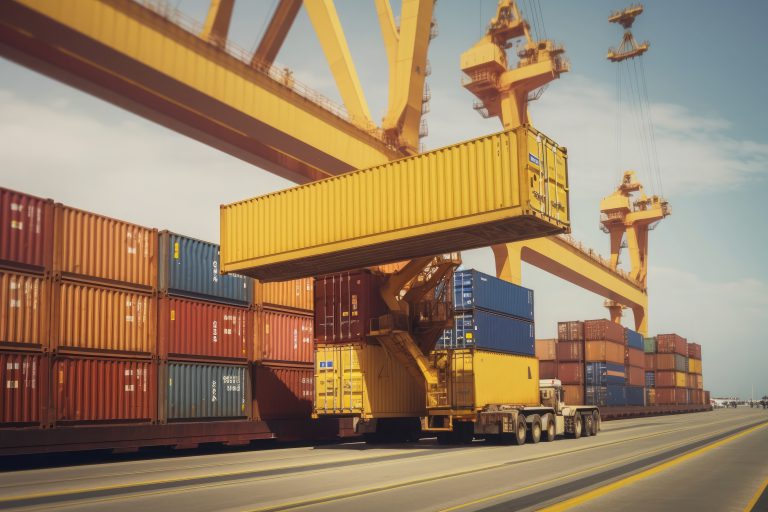Containers Leasing System
Introduction :

Based on our studies directed within the Kingdom of Saudi Arabia market with the aim of developing systems specialized in resource planning for large and medium enterprises (ERP) that serve the nature of the activity of these establishments with non-traditional and distinct specialization, and because these establishments with non-traditional specialization and distinguished by a special nature are considered limited in number, they have not received that attention. It is one of the facilities specialized in developing integrated and interconnected systems and applications (ERP) with accounting and human resources systems as an integrated, unified system. We acknowledge, as a result of these studies and field examination,
the existence of some software solutions that address some of the necessary procedures for these activities independently, away from their connection to the financial and administrative systems of these facilities, which are not It provides a comprehensive and integrated solution, such that these establishments are forced to purchase and use several financial or administrative systems that operate independently of the system of a distinct nature, and they are forced to attempt to link a set of these systems with the system that represents the nature of the facility’s distinct activity. According to our observations, these linking processes are vulnerable to the emergence of errors and mismatches. In the results of operations and their balances between these systems, in addition, the facility that is forced to make this option needs additional human cadres whose task is to make comparisons and matches of the general account balances in the general accounting system and the analytical account balances in the systems associated with them due to the special and distinct activity.
Based on our conviction of the necessity of developing integrated and interconnected systems (ERP) specialized for establishments with distinct and unconventional activities, we explain below the technical details of the integrated container leasing companies management system, which serves the nature of the activity of container leasing companies and institutions of a distinct nature within the Kingdom of Saudi Arabia, a comprehensive system to serve all Financial departments and sections, human resources management, warehouse systems, procurement, periodic maintenance, breakdown maintenance, and follow-up accident procedures in order to be dedicated to and supportive of container rental activity.
List of container leasing companies’ ERP systems :
- User control and powers
- Database management
- Financial systems
- Human resources system
- Fixed assets system
- Purchasing and warehouse system
- Workshop and maintenance system
- Container rental management system
The main menu configuring the container rental management system :
First: System Settings
- Defining container storage sites, specifying and providing the possibility of linking each site to its department and branch, as well as specifying the geographical location and city.
- Definition and classification of container types, with the aim of linking the list of container rental prices according to their types and sizes.
- Container data registration file, linking it to the fixed assets system, and identifying the current warehouse through which it is served.
- A file to record drivers’ data and their work locations.
- Defining the data for each landfill site by specifying the geographical location, data of the person responsible for the site, a description of the site address, and the cost of unloading containers at the site.
- Indexing and classifying service provision sites within the city or region, in order to link the site to rental prices and unloading prices.
- A file for classifying the types of prices used for this system.
- A file to record the types of leasing contracts for containers, as determining the leasing price varies from one type of contract to another.
- Indexing, classifying and defining the types of debit notes to customers. The type of notice is used when approving an amount to be charged to the customer. Each debit note contains a definition of the credit account in the chart of accounts, which represents the credit side of the automated accounting entry issued by recording the movement of a debit note to the customer.
- Indexing, classifying and defining the types of credit notes for the benefit of customers. The type of note is used when approving an amount to be deducted from the customer’s balance, as each credit note contains a definition of the debit account in the chart of accounts, which represents the debit party to the automated accounting entry issued by recording a credit note movement in favor of the customer.
- Classification and definition of the types of representatives working in marketing and sales services for container rental management.
Second: Master Files
- A file containing detailed cash customer data and the link of each customer record to the location of service provision, specifying the department and branch to which the customer record belongs. This file also shows whether the customer is an individual or facility, the means of contacting him, his address and geographical location.
- A file containing detailed forward customer data and the link of each forward customer record to his record in the customer accounts system, as well as identifying the department and branch to which the forward customer record belongs. This file also shows the means of contacting him, his address, and his geographical location.
- A file containing detailed data for each vehicle or container carrier and linking it to the fixed assets system and the driver’s identification of this vehicle, which he retrieves from the drivers’ file.
- A file to record a list of rental prices for containers, as the rental price depends on the type of price, type of rental contract, location of container storage, and location of service provision. It is possible to specify a maximum discount rate for each record.
- A file to record a list of container unloading prices. These prices vary according to the service provision sites and container unloading sites, as well as according to the type of containers.
- A special file for specifying containers allocated to a specific driver, providing the possibility of allocating containers to all drivers at the same location in providing rental services.
Third: Leasing contracts for customers
This list contains a set of administrative and financial transactions and procedures related to container leasing contracts for customers, which are as follows :
- Registration of container leasing contracts.
This procedure enables the user to register a container rental contract for a customer, specifying whether the customer is cash or on credit. The contract contains a work location for the container (warehouse and branch), the location of the service provision, the type of rental price, the type of contract, and the duration and date of the contract. The containers that will be delivered to the customer are also specified. - Building construction licensing contracts.
This procedure enables the user to register a container rental contract for a customer, specifying whether the customer is cash or on credit, with the aim of obtaining building permits for the customer. The contract includes a work location for the container (warehouse and branch), the location of the service provision, the type of rental price, the type of contract, and the duration and date of the contract. This does not include The contract allocates containers to be delivered to the customer. - Receiving advance payment.
This interface provides the receipt of the total value of the contract or a payment of the total value of the contract according to the various payment methods, and this movement produces an automatic accounting entry. - Debit financial note.
This interface enables the user who has the authority to use it to issue a debit financial note by specifying the type of debit note through which an automatic accounting entry is issued, while providing the ability to pay the amount of the debit note to the customer from this same screen or interface. - Credit financial note.
This interface enables the user who has the authority to use it to issue a financial credit note by specifying the type of credit note through which an automatic accounting entry is issued. - Add containers to a contract.
This interface enables one or more containers to be added to an existing contract before the expiration of this contract. - Cancel containers from a contract.
This interface enables one or more containers of an existing contract to be canceled before the expiration of the term of this contract. - Extending customer rental contracts.
This interface provides, at any date from the beginning of the contract, the possibility of extending the contract period, while providing the possibility of receiving the payment amount for the extended period through the same screen or interface.
Fourth: Operating procedures
This list contains a set of financial movements and procedures that are completely related to the nature of the activity of container leasing companies and are as follows :
- Container delivery.
This screen provides documentation of the process of delivering the container to the customer with the ability to archive the customer’s signature of receipt if the customer has contracted to include the archiving system with the systems components. - Replace container.
When the contract is for a long period, this screen provides the possibility of replacing the full container with an empty one, and because the customer must pay an additional amount for the process of unloading the container, this screen provides the possibility of receiving the amount for unloading according to the appropriate payment methods for the customer, and this movement results in the issuance of an automatic accounting entry. . - Customer payments.
This screen provides the receipt of customer payments, and this movement produces an automatic accounting entry. - Invoicing container rental contracts.
This screen provides the possibility of invoicing a rental contract that has not been previously invoiced, noting that this transaction results in an accounting entry regarding the entitlement to revenue from the account. It also enables the user from the same screen to receive the amount for the invoice, taking into account deducting the value of any previous payments. - Invoicing building construction licensing contracts.
This screen provides the ability to invoice a license contract for building construction that has not been previously invoiced, noting that this transaction results in an accounting entry related to the entitlement to revenue from the client. The user from the same screen also enables the user to receive the amount for the invoice, taking into account deducting the value of any previous payments. - Receiving containers.
This screen provides the possibility of receiving expired containers from the customer’s location, while providing the ability to receive any remaining amounts as a balance on the customer to close the contract and issue an automatic accounting entry.









